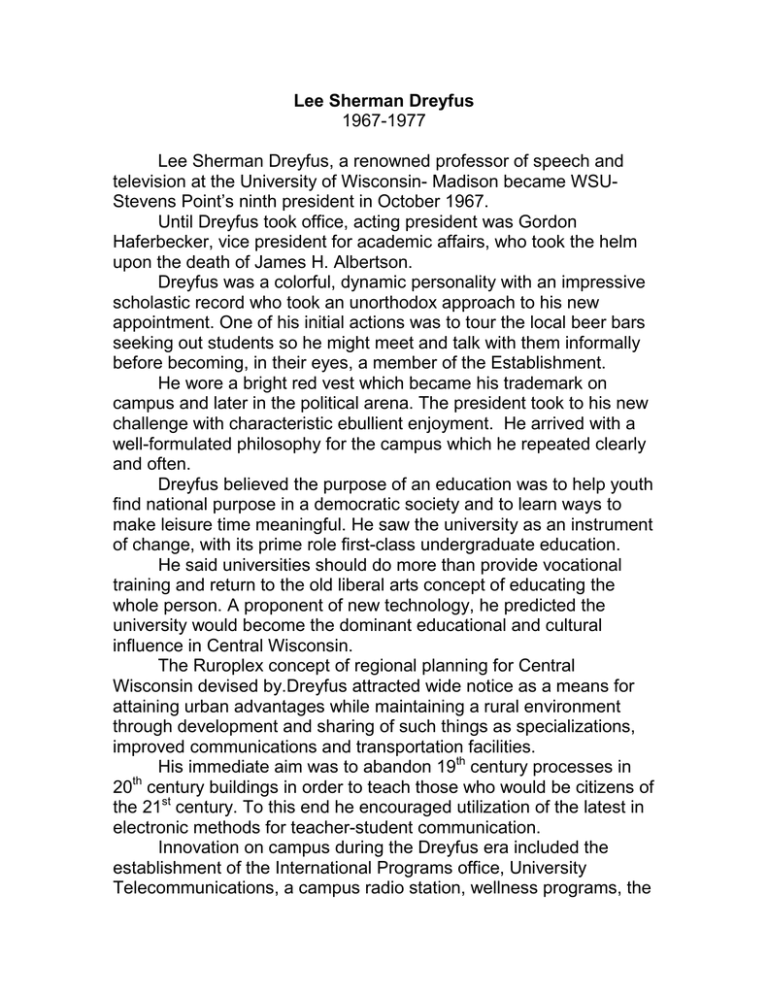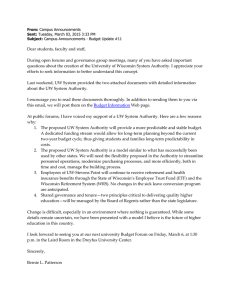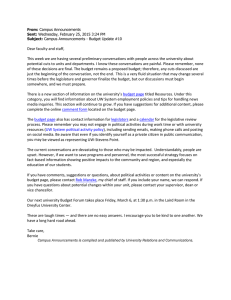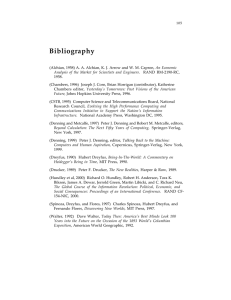Lee Sherman Dreyfus 1967-1977
advertisement

Lee Sherman Dreyfus 1967-1977 Lee Sherman Dreyfus, a renowned professor of speech and television at the University of Wisconsin- Madison became WSUStevens Point’s ninth president in October 1967. Until Dreyfus took office, acting president was Gordon Haferbecker, vice president for academic affairs, who took the helm upon the death of James H. Albertson. Dreyfus was a colorful, dynamic personality with an impressive scholastic record who took an unorthodox approach to his new appointment. One of his initial actions was to tour the local beer bars seeking out students so he might meet and talk with them informally before becoming, in their eyes, a member of the Establishment. He wore a bright red vest which became his trademark on campus and later in the political arena. The president took to his new challenge with characteristic ebullient enjoyment. He arrived with a well-formulated philosophy for the campus which he repeated clearly and often. Dreyfus believed the purpose of an education was to help youth find national purpose in a democratic society and to learn ways to make leisure time meaningful. He saw the university as an instrument of change, with its prime role first-class undergraduate education. He said universities should do more than provide vocational training and return to the old liberal arts concept of educating the whole person. A proponent of new technology, he predicted the university would become the dominant educational and cultural influence in Central Wisconsin. The Ruroplex concept of regional planning for Central Wisconsin devised by.Dreyfus attracted wide notice as a means for attaining urban advantages while maintaining a rural environment through development and sharing of such things as specializations, improved communications and transportation facilities. His immediate aim was to abandon 19th century processes in 20th century buildings in order to teach those who would be citizens of the 21st century. To this end he encouraged utilization of the latest in electronic methods for teacher-student communication. Innovation on campus during the Dreyfus era included the establishment of the International Programs office, University Telecommunications, a campus radio station, wellness programs, the Suzuki Institute, and programs to encourage cultural diversity. The first meeting of the Faculty Senate was convened in September, 1972. A time of tremendous growth on campus, Old Main was renovated and new buildings included the Fine Arts Center, Albertson Learning Resources Center, College of Professional Studies and College of Natural Resources. Additions were made to the physical education building and the Science Building. The campus also expanded with the development of the Central Wisconsin Environmental Station at Sunset Lake and Schmeeckle Reserve on north campus, including a man-made lake, later named Lake Dreyfus. A massive computer-generated mosaic mural was constructed by Professor Richard Schneider on the south wall of the Natural Resources Building. Dreyfus was “energetic, outspoken and quotable,” qualities which in ordinary circumstances might involve any man in controversies. And no university president at the time found himself in ordinary circumstances. Across the country, a spirit of social protest was rampant. There was more activism at WSU than ever before, but involvement was considered preferable to apathy by most in the academic environment. Antiwar protests, including a sit-in at Nelson Hall, provided a challenge for the campus. WSU-Stevens Point had its share of issues including the banning of the Students for a Democratic Society and the adoption of a Student Conduct Code by the Board of Regents. Another controversy had to do with language used in an underground newspaper edited by some young faculty members. As the campus unrest abated, Dreyfus turned his attention to the merger of the state’s two university systems. He helped to persuade both state officials and the WSU faculty of its merit and merger was successfully completed in 1971, creating a new University of Wisconsin System and a new University of WisconsinStevens Point. In 1977 Dreyfus took a leave of absence from campus to successfully run for Governor of Wisconsin on the Republican ticket. During that period, Vice President John B. Ellery served as acting chancellor until the appointment of Philip Marshall in 1979.




